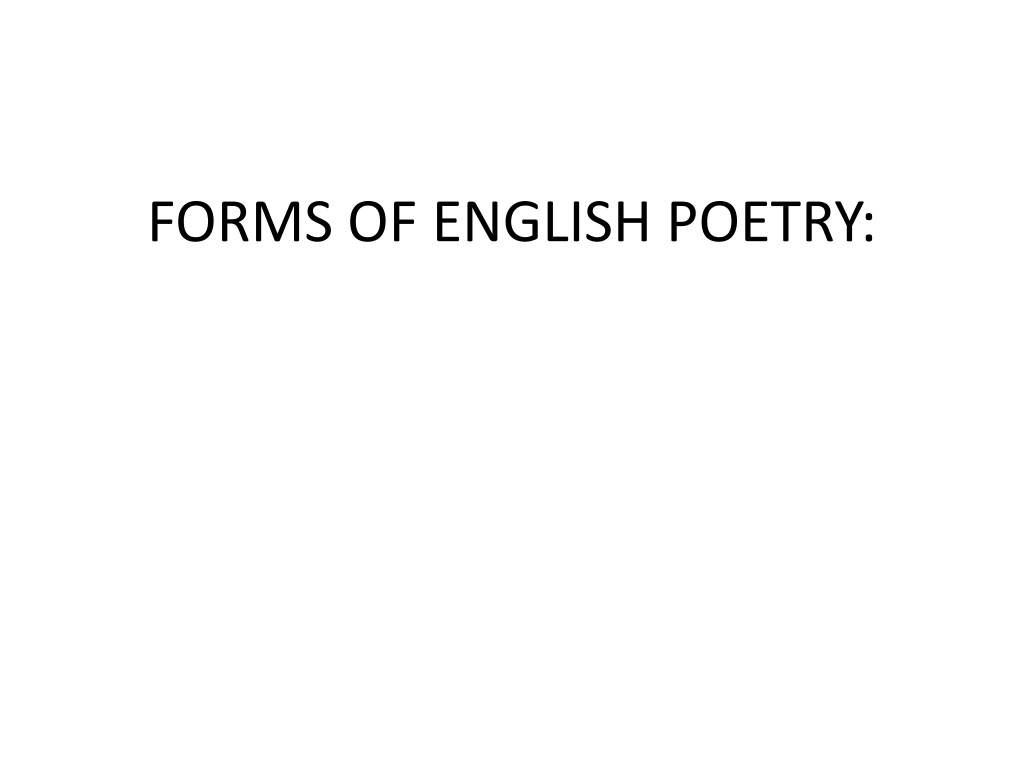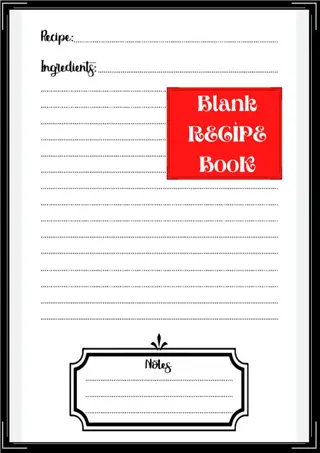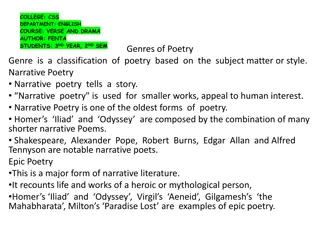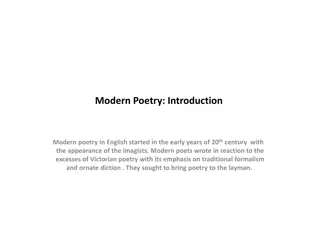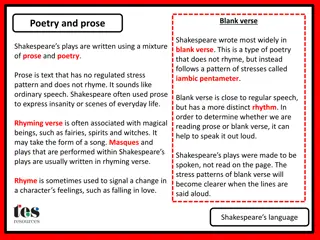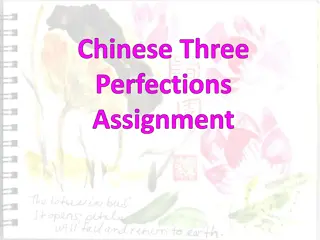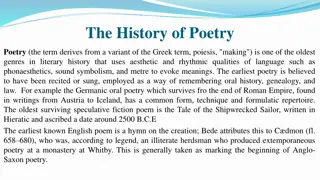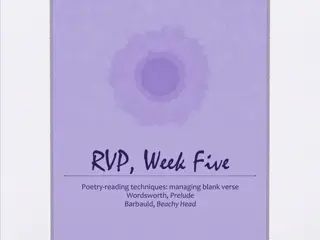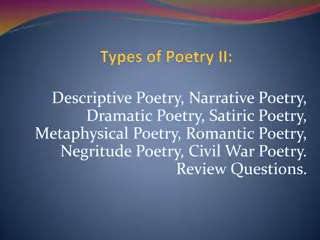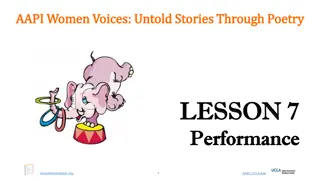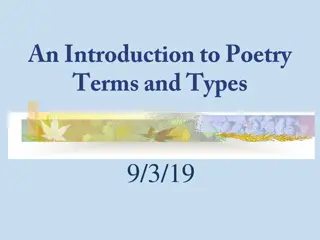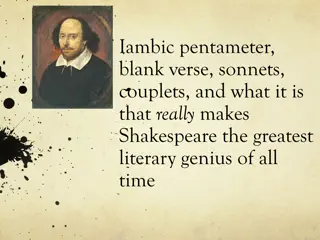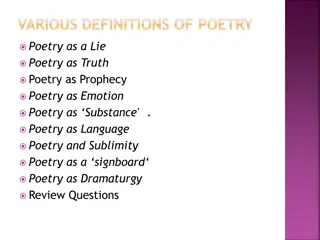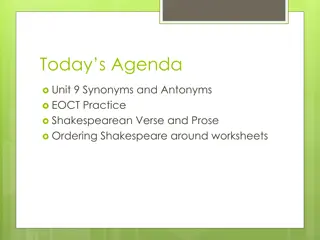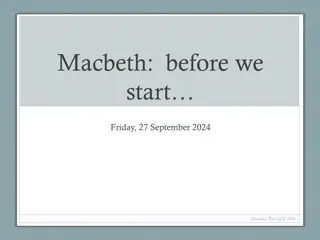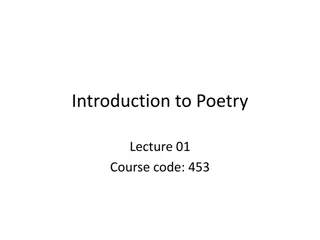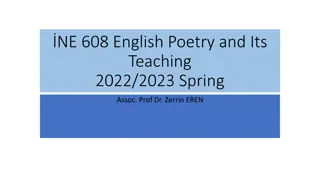Forms of English Poetry: Blank Verse and Free Verse
Discover the nuances of Blank Verse and Free Verse in English poetry. Blank verse, characterized by unrhymed iambic pentameter, offers a structured yet flexible form for poetic expression. On the other hand, Free Verse grants poets the freedom to experiment with words unrestricted by traditional rhyme and meter patterns. Explore the history, characteristics, and examples of these two significant forms to enrich your appreciation of poetic diversity.
Download Presentation

Please find below an Image/Link to download the presentation.
The content on the website is provided AS IS for your information and personal use only. It may not be sold, licensed, or shared on other websites without obtaining consent from the author.If you encounter any issues during the download, it is possible that the publisher has removed the file from their server.
You are allowed to download the files provided on this website for personal or commercial use, subject to the condition that they are used lawfully. All files are the property of their respective owners.
The content on the website is provided AS IS for your information and personal use only. It may not be sold, licensed, or shared on other websites without obtaining consent from the author.
E N D
Presentation Transcript
Blank verse: Blank verse is poetry written in regular metrical but unrhymed lines. Blank verse is mostly written in iambic pentameter. Blank verse is also known as unrhymed iambic pentameter. This type of verse contains a consistent meter with 10 syllables in each line. The unstressed syllables are followed by stressed ones; therefore, it contains five stressed syllables.
Blank verse is said to be one of the most common and influential forms in English poetry. It is appeared in the sixteenth century and has been famously employed by poets and many of the English poems have been written in this style. Henry Howard, Earl of Surrey, is considered as the first poets to use blank verse in English literature.
EXAMPLE Something there is that doesn t love a wall. That sends the frozen-ground-swell under it, And spills the upper boulders in the sun;
Free verse: Free verse is a form of poetry that does not use a consistent meter, rhyme or any other pattern. Although it is devoid of regular rhyme, rhythm or 5 meter, it still provides artistic expressions. It tends to follow the rhythm of natural speech. Since it does not follow set rules, the poet can give any shape to a poem.
Free verse also gives a greater freedom for poets to choose words without bothering about the rhyme and rhythm. It is commonly used in contemporary poetry. Free verse poetry has been popular from the nineteenth century onward
EXAMPLE "After the Sea-Ship" by Walt Whitman After the Sea-Ship-after the whistling winds; After the white-gray sails, taut to their spars and ropes, Below, a myriad, myriad waves, hastening, lifting up their necks, Tending in ceaseless flow toward the track of the ship: Waves of the ocean, bubbling and gurgling, blithely prying, Waves, undulating waves-liquid, uneven, emulous waves, Toward that whirling current, laughing and buoyant, with curves, Where the great Vessel, sailing and tacking, displaced the surface;
TYPES OF POETRY AND THEIR CHARACTERISTICS 1- Narrative As its name implies, narrative poetry is concerned with storytelling. Just as in a prose story, a narrative poem most likely follow the conventions of plot including elements such as conflict, rising action, climax, resolution etc.
EXAMPLE "Son," said my mother, When I was knee-high, "You've need of clothes to cover you, And not a rag have I. "There's nothing in the house To make a boy breeches, Nor shears to cut a cloth with Nor thread to take stitches. "There's nothing in the house But a loaf-end of rye,
2- Descriptive Descriptive poetry usually employs lots of rich imagery to describe the world around the poet. While it most often has a single poetic voice and a strong emotional content, descriptive poetry differs from lyric poetry in that its focus is more on the externalities of the world, rather than the interior life of the poet.
EXAMPLE Her hair as dark as midnight Sleek and wavy, trailing down. Her skin as pale as moonlight Projects a silvery glow all around. The night so cool and quiet, As the stars twinkle in the sky. And all of nature stands in awe, As this beauty passes by.
3- Epics An epic poem is a lengthy, narrative work of poetry. These long poems typically detail extraordinary feats and adventures of characters from a distant past. But before they were documented in prose, these lengthy narratives fell into the domain of epic poetry.
The main features of epic poetry formal style brave heroes supernatural elements journeys narrator long in length
EXAMPLE Tell me, O muse, of that ingenious hero who travelled far and wide after he had sacked the famous town of Troy. Many cities did he visit, and many were the nations with whose manners and customs he was acquainted; moreover he suffered much by sea while trying to save his own life and bring his men safely home; but do what he might he could not save his men, for they perished through their own sheer folly in eating the cattle of the Sun-god Hyperion; so the god prevented them from ever reaching home. Tell me, too, about all these things, O daughter of Jove, from whatsoever source you may know them.
